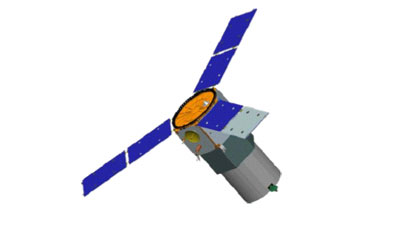|
|
 Hyperspectral sensors like the one to be tested on TacSat-3 (above) could aid efforts to detect missiles before they’re launched, but such systems are still well off in the future. (credit: US Air Force) |
Missile defense, satellites, and politics
by Taylor Dinerman
Monday, June 11, 2007
Politics and presidential campaigns have a way of oversimplifying the most complex of issues. Take, for example, a comment by Sen. Joe Biden of Delaware during a debate of Democratic presidential candidates in New Hampshire on June 3. Asked about the threat posed by Iran’s nuclear and long-range missile programs, he downplayed the issue, but concluded, “But at the end of the day, if they posed a missile, stuck it on a pad, I’d take it out.”
But what kind of a missile, Senator? How would you know what kind of a warhead it had? They are sticking quite a few Shehab 3 missiles on pads as part of their development, test, and training programs. The analysis process would take days or weeks, and even then, could you trust the intelligence community to get it right? It might just be a satellite launcher, and certainly one should expect that the Iranians would claim that they were just preparing a peaceful scientific launch when the US attacked them.
There is also the question of actually locating such a missile. In 1962 the Kennedy administration had a very hard time trying to find all the Soviet missiles in Cuba. Our ability to search for these missiles has improved, but so have the techniques used to hide them. The Great Scud Hunt of 1991 failed to stop a single missile from being fired. The mobile launchers used by Saddam’s Iraq were able to keep shooting at Israel, Saudi Arabia, and at other targets right up until the end of the war. In 1944 and 1945, Nazi Germany’s V-2 units were able to keep bombarding London and Antwerp in the teeth of Allied air supremacy.
History shows that trying to stop missiles while they are still on the ground is a losing proposition. It may sound good to say you want to shut down the attacks at the source, but there are so many ways to hide a missile and its launcher that even the most sophisticated sensor to shooter systems cannot effectively suppress a determined effort. The Israelis found this out last summer in their campaign against Hezbollah’s rocket offensive.
US spy satellites are good, but there are not enough of them to be able to revisit potential launch sites often enough to be sure that we can really detect when a missile is about to be launched or even if it has been fueled up and ready to go. Before a rocket engine has been ignited there are few detectable signs that it is ready to go; this holds true for liquid-fueled rockets and even more so for one with solid-fuel engines.
| US spy satellites are good, but there are not enough of them to be able to revisit potential launch sites often enough to be sure that we can really detect when a missile is about to be launched or even if it has been fueled up and ready to go. |
However, future space-based sensors could make it easier to detect missiles being prepared for launch. Large-scale use of hyperspectral sensors on satellites derived from the Air Force’s TacSat-3, now scheduled for launch sometime this winter, may be able to give some warning, although no plans exist today to provide for such a capability. Even if the decision were made today to build such a constellation of satellites, our slow-moving bureaucracy insures that it would take at least a decade before the US had a meaningful number of such spacecraft. Meanwhile, the US Senate’s Intelligence Committee just zeroed out funds for the Space Radar program, which might someday be able to track missiles on the ground through a common form of camouflage known as clouds.
Once a rocket has been launched and is in the so-called “boost phase”, however, things change. It is vulnerable to being detected and tracked by thermal sensors or by radar. If the right weapons are available it can then be destroyed by kinetic means or perhaps soon by lasers. The Congressional Democrats, however, have cut funding for the Airborne Laser program, mounted on a 747. If it is completed, it would be able to shoot down missiles in flight, shortly after launch. The Democrats also propose to zero out the $10-million dollar request the Missile Defense Agency made to begin studies for a space based boost phase defense. And they have cut the promising Miniature Kill Vehicle (MKV) program.
Effective missile defense needs to be multi-layered and above all has to be able to hit enemy missiles in the very early stages of flight before they deploy decoys. Midcourse weapons such as the Ground Based Interceptors now being deployed in Alaska and California, and proposed for deployment in Poland, have a much harder job hitting their targets while they are in free flight hundreds of kilometers above the Earth. Midcourse weapons are only truly effective if they are used as back ups for boost phase interceptors and the most effective of these have to be based in space.
Senator Biden seems pretty sure that the Iranians are many years away from combining a nuclear warhead with a long-range missile. In any case we know that the US is still years away from deploying an effective multi-layered defense.
Taylor Dinerman is an author and journalist based in New York City.
|
|
